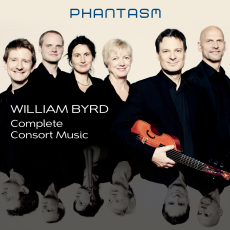Phantasm - William Byrd -Fanfare
There has only been one previous collection of the complete music of William Byrd for viol consort, a 1994 issue on the Virgin Classics label with the well-known Fretwork ensemble still available as an ArkivMusic reissue. This collection is overall slightly more "complete" than its predecessor; both collections claim to include all the works that did not require major reconstructions to compensate for defective manuscripts, but apparently the definition of that lies in the eye of the musicological beholder. This anthology includes two works not present on the Fretwork CD-the Fantasia à 3 No. 3 (neither disc contains a Fantasia à 3 No. 2) and the Fantasia à 6 No. 1-and a more complete version of Te lucis à 4 No. 2 (the Fretwork version offers only the second verse), but it omits one piece found on the Fretwork release, the In nomine à 5 No. 1. Given that this CD is filled to digital capacity, an additional two-and-one-half minute work could not be squeezed in on one disc, but the omission is not explained.
Given that both recordings are excellent, a choice between the two is mostly a matter of taste. Phantasm has a somewhat sweeter, deeper, more velvety tone, while Fretwork plays with slightly more rhythmic edge and impulse, and also has the discreet participation in some works of lutenist Christopher Wilson. The Phantasm release contains slightly more music, but the Fretwork CD is five dollars cheaper, and I do not find that the SACD sound of this new disc makes a whit of difference for listening to a viol consort. Timings do not differ greatly overall; both booklets have excellent notes, though the Linn release provides a neat table laying out the likely chronological order of composition of the various pieces, while the Virgin Classics notes provide the same information in somewhat wordy prose. One major advantage of the Fretwork CD is that, with one exception, it groups together in sequential order all compositions with the same title (e.g., all five of the In nomine à 5 pieces), whereas the ordering of them on the Linn disc is entirely random. (Doesn't it ever occur to the producers of these releases that if someone wants to listen to such works in a random sequence, they have an option for doing so on their CD players, instead of making a given piece much more difficult to find?). Personally I lean more toward the Fretwork interpretations, but you can't go wrong either way. For fellow lovers of viol consort music, this disc is highly recommended if you don't already have the repertoire; if you already own the previous Fretwork release, it's gravy but not meat.

